Page 154 of 494
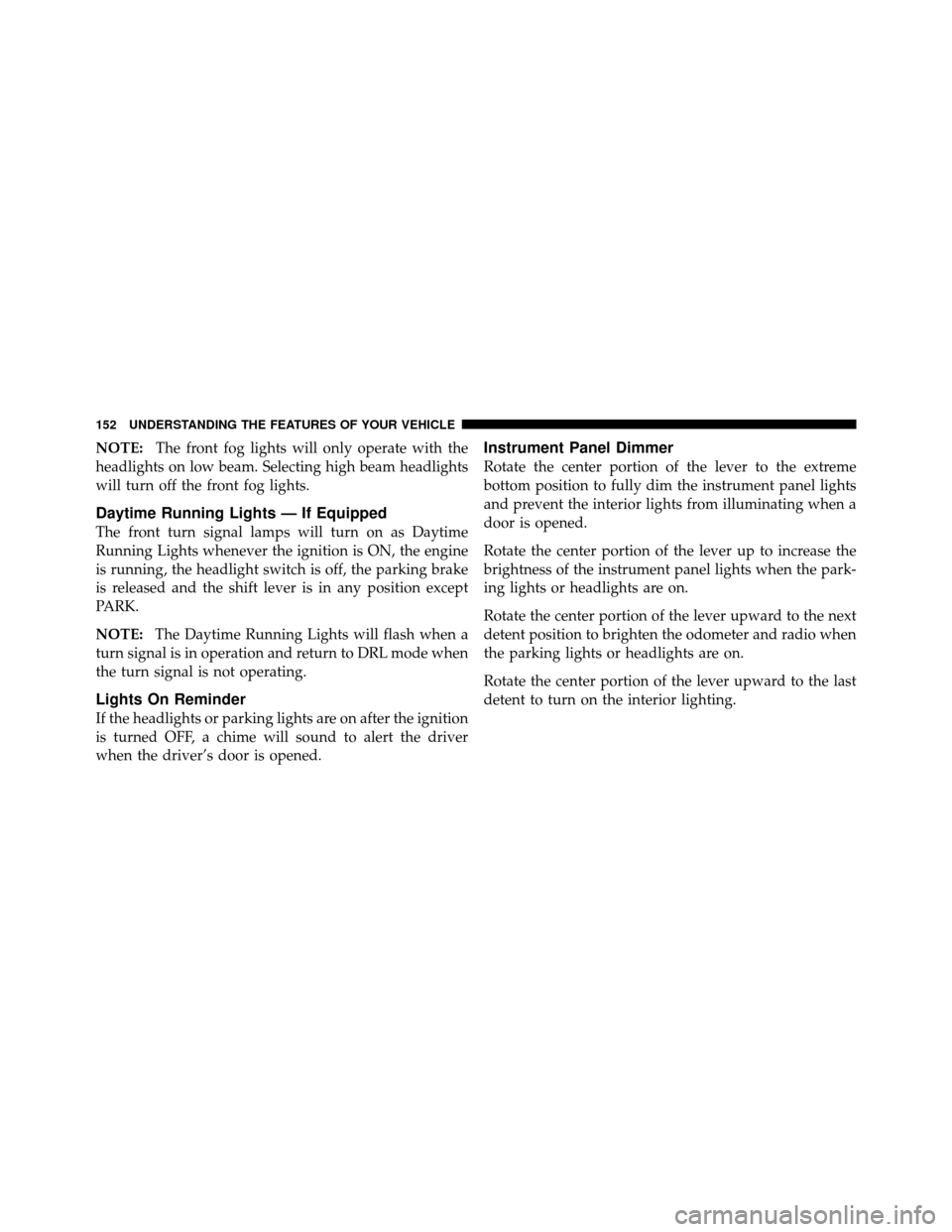
NOTE:The front fog lights will only operate with the
headlights on low beam. Selecting high beam headlights
will turn off the front fog lights.
Daytime Running Lights — If Equipped
The front turn signal lamps will turn on as Daytime
Running Lights whenever the ignition is ON, the engine
is running, the headlight switch is off, the parking brake
is released and the shift lever is in any position except
PARK.
NOTE: The Daytime Running Lights will flash when a
turn signal is in operation and return to DRL mode when
the turn signal is not operating.
Lights On Reminder
If the headlights or parking lights are on after the ignition
is turned OFF, a chime will sound to alert the driver
when the driver’s door is opened.
Instrument Panel Dimmer
Rotate the center portion of the lever to the extreme
bottom position to fully dim the instrument panel lights
and prevent the interior lights from illuminating when a
door is opened.
Rotate the center portion of the lever up to increase the
brightness of the instrument panel lights when the park-
ing lights or headlights are on.
Rotate the center portion of the lever upward to the next
detent position to brighten the odometer and radio when
the parking lights or headlights are on.
Rotate the center portion of the lever upward to the last
detent to turn on the interior lighting.
152 UNDERSTANDING THE FEATURES OF YOUR VEHICLE
Page 165 of 494
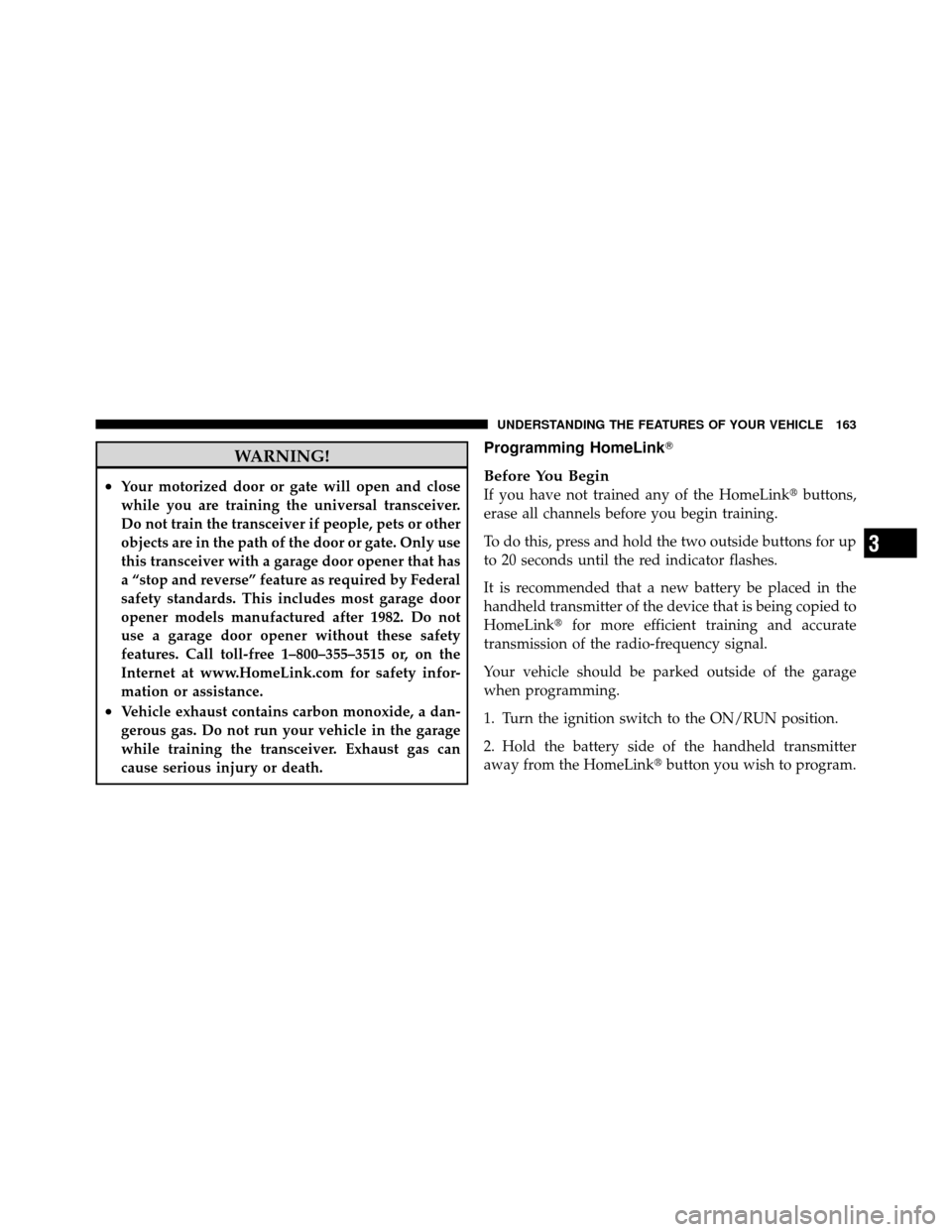
WARNING!
•Your motorized door or gate will open and close
while you are training the universal transceiver.
Do not train the transceiver if people, pets or other
objects are in the path of the door or gate. Only use
this transceiver with a garage door opener that has
a “stop and reverse” feature as required by Federal
safety standards. This includes most garage door
opener models manufactured after 1982. Do not
use a garage door opener without these safety
features. Call toll-free 1–800–355–3515 or, on the
Internet at www.HomeLink.com for safety infor-
mation or assistance.
•Vehicle exhaust contains carbon monoxide, a dan-
gerous gas. Do not run your vehicle in the garage
while training the transceiver. Exhaust gas can
cause serious injury or death.
Programming HomeLink�
Before You Begin
If you have not trained any of the HomeLink�buttons,
erase all channels before you begin training.
To do this, press and hold the two outside buttons for up
to 20 seconds until the red indicator flashes.
It is recommended that a new battery be placed in the
handheld transmitter of the device that is being copied to
HomeLink� for more efficient training and accurate
transmission of the radio-frequency signal.
Your vehicle should be parked outside of the garage
when programming.
1. Turn the ignition switch to the ON/RUN position.
2. Hold the battery side of the handheld transmitter
away from the HomeLink� button you wish to program.
3
UNDERSTANDING THE FEATURES OF YOUR VEHICLE 163
Page 168 of 494
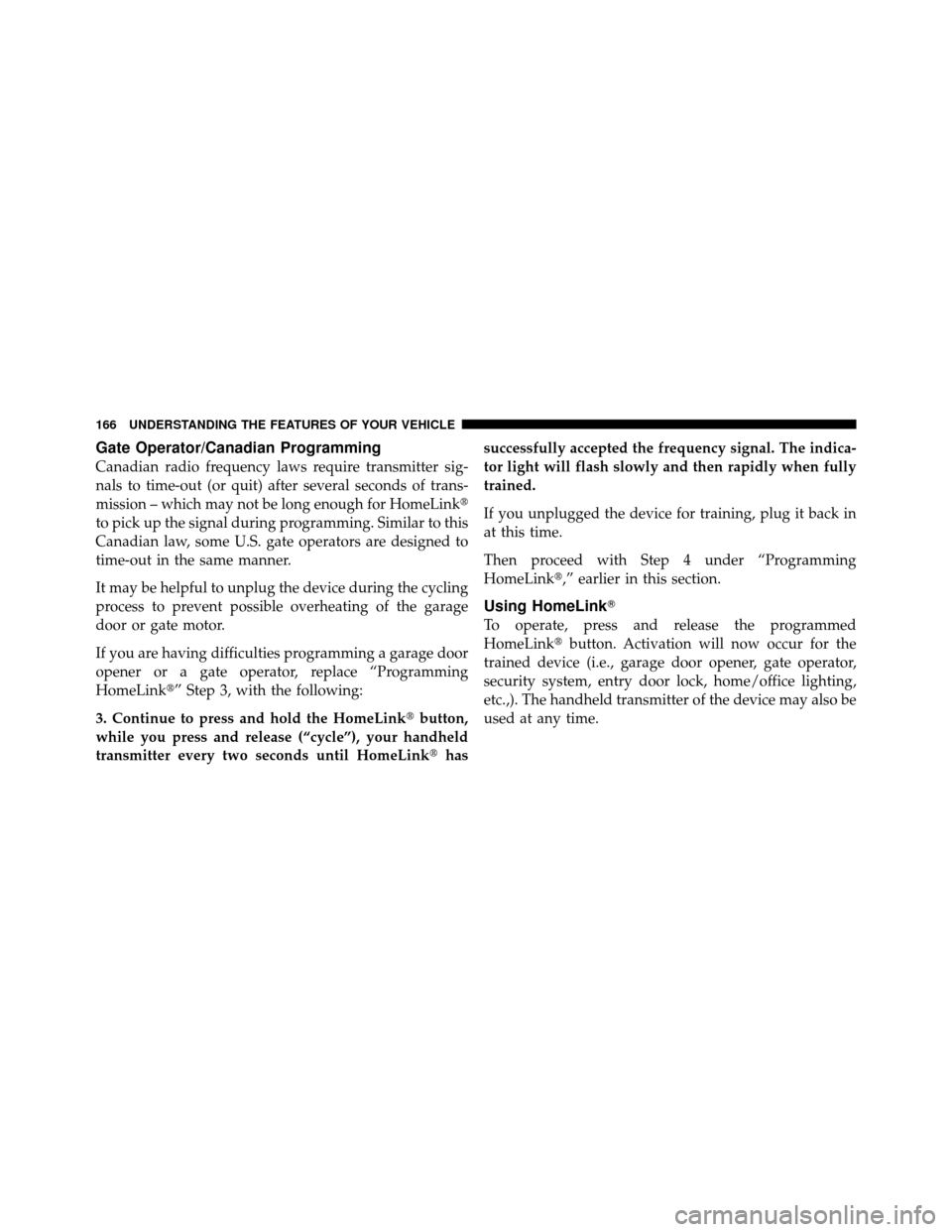
Gate Operator/Canadian Programming
Canadian radio frequency laws require transmitter sig-
nals to time-out (or quit) after several seconds of trans-
mission – which may not be long enough for HomeLink�
to pick up the signal during programming. Similar to this
Canadian law, some U.S. gate operators are designed to
time-out in the same manner.
It may be helpful to unplug the device during the cycling
process to prevent possible overheating of the garage
door or gate motor.
If you are having difficulties programming a garage door
opener or a gate operator, replace “Programming
HomeLink�” Step 3, with the following:
3. Continue to press and hold the HomeLink�button,
while you press and release (“cycle”), your handheld
transmitter every two seconds until HomeLink� hassuccessfully accepted the frequency signal. The indica-
tor light will flash slowly and then rapidly when fully
trained.
If you unplugged the device for training, plug it back in
at this time.
Then proceed with Step 4 under “Programming
HomeLink�,” earlier in this section.
Using HomeLink�
To operate, press and release the programmed
HomeLink�
button. Activation will now occur for the
trained device (i.e., garage door opener, gate operator,
security system, entry door lock, home/office lighting,
etc.,). The handheld transmitter of the device may also be
used at any time.
166 UNDERSTANDING THE FEATURES OF YOUR VEHICLE
Page 185 of 494
UNDERSTANDING YOUR INSTRUMENT PANEL
CONTENTS
�Instrument Panel Features ............... 186
� Instrument Cluster .................... 187
� Instrument Cluster Descriptions ........... 188
� Mini-Trip Computer — If Equipped ........ 201
▫ Control Buttons ..................... 202
� Electronic Vehicle Information Center
(EVIC) – If Equipped .................... 203
▫ Electronic Vehicle Information Center (EVIC)
Displays ........................... 205
▫ Oil Change Required — If Equipped ...... 206▫
Trip Functions ...................... 207
▫ Display Units In ..................... 208
▫ TirePsi ........................... 209
▫ Compass Display .................... 209
▫ Personal Settings
(Customer-Programmable Features) ....... 212
� Media Center 230 (REQ) — AM/FM Stereo
Radio And 6–Disc CD/DVD Changer
(MP3/WMA AUX Jack) .................. 215
▫ Operating Instructions - Radio Mode ...... 215
4
Page 186 of 494
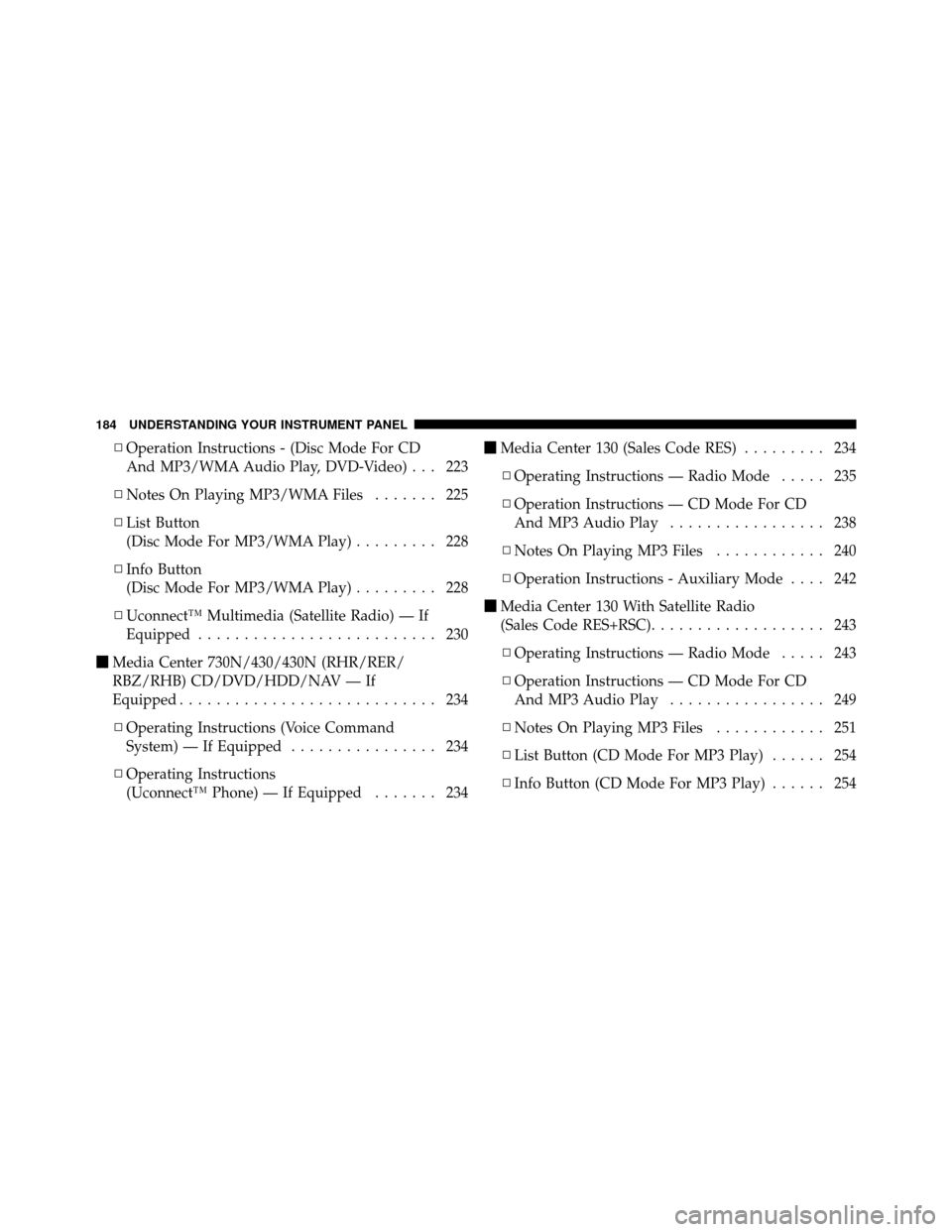
▫Operation Instructions - (Disc Mode For CD
And MP3/WMA Audio Play, DVD-Video) . . . 223
▫ Notes On Playing MP3/WMA Files ....... 225
▫ List Button
(Disc Mode For MP3/WMA Play) ......... 228
▫ Info Button
(Disc Mode For MP3/WMA Play) ......... 228
▫ Uconnect™ Multimedia (Satellite Radio) — If
Equipped .......................... 230
� Media Center 730N/430/430N (RHR/RER/
RBZ/RHB) CD/DVD/HDD/NAV — If
Equipped ............................ 234
▫ Operating Instructions (Voice Command
System) — If Equipped ................ 234
▫ Operating Instructions
(Uconnect™ Phone) — If Equipped ....... 234�
Media Center 130 (Sales Code RES) ......... 234
▫ Operating Instructions — Radio Mode ..... 235
▫ Operation Instructions — CD Mode For CD
And MP3 Audio Play ................. 238
▫ Notes On Playing MP3 Files ............ 240
▫ Operation Instructions - Auxiliary Mode .... 242
� Media Center 130 With Satellite Radio
(Sales Code RES+RSC) ................... 243
▫ Operating Instructions — Radio Mode ..... 243
▫ Operation Instructions — CD Mode For CD
And MP3 Audio Play ................. 249
▫ Notes On Playing MP3 Files ............ 251
▫ List Button (CD Mode For MP3 Play) ...... 254
▫ Info Button (CD Mode For MP3 Play) ...... 254
184 UNDERSTANDING YOUR INSTRUMENT PANEL
Page 187 of 494
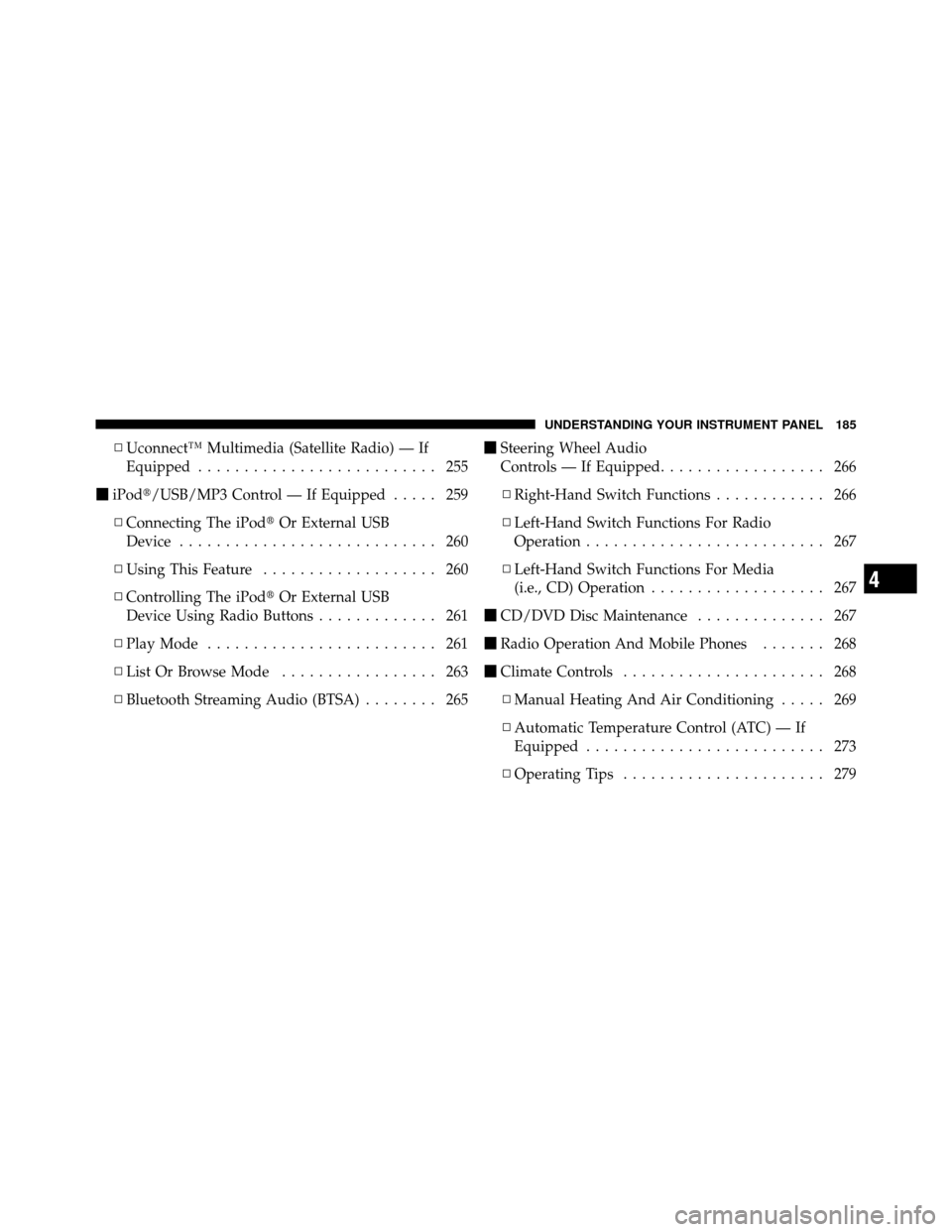
▫Uconnect™ Multimedia (Satellite Radio) — If
Equipped .......................... 255
� iPod�/USB/MP3 Control — If Equipped ..... 259
▫ Connecting The iPod� Or External USB
Device ............................ 260
▫ Using This Feature ................... 260
▫ Controlling The iPod� Or External USB
Device Using Radio Buttons ............. 261
▫ Play Mode ......................... 261
▫ List Or Browse Mode ................. 263
▫ Bluetooth Streaming Audio (BTSA) ........ 265�
Steering Wheel Audio
Controls — If Equipped .................. 266
▫ Right-Hand Switch Functions ............ 266
▫ Left-Hand Switch Functions For Radio
Operation .......................... 267
▫ Left-Hand Switch Functions For Media
(i.e., CD) Operation ................... 267
� CD/DVD Disc Maintenance .............. 267
� Radio Operation And Mobile Phones ....... 268
� Climate Controls ...................... 268
▫ Manual Heating And Air Conditioning ..... 269
▫ Automatic Temperature Control (ATC) — If
Equipped .......................... 273
▫ Operating Tips ...................... 279
4
UNDERSTANDING YOUR INSTRUMENT PANEL 185
Page 188 of 494
INSTRUMENT PANEL FEATURES
1 — Air Outlet5 — Passenger Airbag9 — Power Outlet
2 — Side Window Demister Outlet 6 — Glove Compartment 10 — Climate Controls
3 — Instrument Cluster 7 — Heated Seat Switch — If Equipped 11 — Ignition Switch
4 — Radio 8 — Hazard Switch12 — Trunk Release Button
186 UNDERSTANDING YOUR INSTRUMENT PANEL
Page 205 of 494
ELECTRONIC VEHICLE INFORMATION CENTER
(EVIC) – IF EQUIPPED
The Electronic Vehicle Information Center (EVIC) fea-
tures a driver-interactive display that is located in the
instrument cluster.The EVIC consists of the following:•Compass Heading Display (N, S, E, W, NE, NW, SE,
SW)
•Mileage (Avg/MPG)
•Miles To Empty
•Low Tire Information (Tire Pressure Monitor System
(TPMS) Displays) — if equipped
•Timer
•Units
•System Warnings (Door Ajar, etc.)
•Personal Settings (Customer-Programmable Features)
•Outside Temperature Display (°F or °C)
•Audio Mode Displays – 12 preset Radio Stations or CD
Title and Track number when playingElectronic Vehicle Information Center (EVIC)
4
UNDERSTANDING YOUR INSTRUMENT PANEL 203